Unlock the potential of AI content and SEO with our guide to ChatGPT Prompt Engineering. Powerful ChatGPT SEO prompts that will transform how you work.
Jump to section hide
- 1 Unlock the potential of AI content and SEO with our guide to ChatGPT Prompt Engineering. Powerful ChatGPT SEO prompts that will transform how you work.
- 2 Background
- 3 What are AI prompts?
- 4 What is prompt engineering?
- 5 Why do I need to know all this?
- 6 The basics, understanding triggers and action words
- 7 The science of engineering ChatGPT prompts effectively
- 8 Our reusable ChatGPT prompt engineering formula for website content
- 9 ChatGPT prompt engineering formula for blog posts and articles
- 10 Progressive ChatGPT prompt engineering
- 11 ChatGPT SEO prompts and examples
- 12 A bit more about writing styles, tones, languages and even roles as prompts
- 13 Other useful resources for AI prompt engineering
- 14 Conclusion: the power of ChatGPT prompt engineering for SEO
Background
Are you ready to take your game to the next level with ChatGPT SEO prompts? If so, you don’t want to miss out on our guide to ChatGPT prompt engineering!

A person contemplating their ChatGPT SEO prompts by DALL-E
As part of our ongoing exploration of Artificial Intelligence, ChatGPT and GPT models like GPT-3 and GPT-4, we’re excited to share our latest guide on ChatGPT prompt engineering. In this guide, we’ll dive deep into the world of ChatGPT SEO prompts, explore what they are, how to engineer them effectively and provide real-world examples that can be reused in your own SEO and content creation.
We’ve already covered a great deal in our previous guides, including the following titles:
- Guide to using AI for SEO
- Evaluation of AI content detection tools
- Exploration of ChatGPT as a meta data tool
- How to use ChatGPT as a marketing ideas generator
- Using ChatGPT to analyse Google Analytics SEO data
- Using ChatGPT to analyse Google Search Console SEO data
But that’s not all. We’re also thrilled to announce the launch of our free WordPress plugin, AI-Scribe, the ChatGPT Content Creator Wizard. The plugin can build an entire article from the ground up with SEO at the forefront and all of the best practices outlined within the anatomy of a perfect blog post article by Hubspot. We’re glad to say, it’s now ready and live and can be downloaded using the above link.
With our philosophy of open source in mind, we thought, hey, let’s share our findings with everybody. Whether you’re a seasoned ChatGPT user or just starting out, we guarantee you’ll come away with new ideas or strategies to apply within your marketing.
What are AI prompts?
AI prompts are crucial to natural language processing (NLP) technologies like ChatGPT.
They are a set of instructions that guide the AI model in generating results. Whether using an AI image generation tool like DALL-E or Stable Diffusion, or a chatbot tool like ChatGPT, entering the right AI prompt is essential to get the desired output.
In a similar way to a natural language when speaking to somebody, your choice of question and how you phrase it will help to determine the answer you get.
What is prompt engineering?
Prompt engineering is the art of crafting effective prompts to be used within AI. Going back to the example of natural human language, prompt engineering is a bit like a person being educated on how to communicate in certain scenarios, e.g. sales, negotiation, education, etc. It’s certainly much closer to this than code engineering for example.
The quality of your AI prompts can make or break the success of your efforts. Effective prompts should be specific, clear and tailored to your target audience. They should also take into account the goals and desired outcomes of what you are trying to achieve.
By engineering AI prompts that are well-suited to your needs, you can ensure that tools like ChatGPT are able to produce a result that is engaging, informative, and relevant to your audience.
Why do I need to know all this?
In the fast-paced world of digital marketing, staying ahead of the curve is essential. Not only that, but we believe the world is seeing a kind of AI inflection point right now and a cultural shift not seen since the dawn of the Internet. A change like this will impact how we all go about our daily lives.
Imagine life without understanding how to use the internet or smartphone? We’re only talking about 20-40 years ago, but it would be like the dark ages compared to today. This is what we believe is happening right now with AI and the need to understand AI prompts will become essential for all of us. Just as the internet and smartphones make access to information much faster, AI tools like ChatGPT are doing the same but at an even greater pace, and with the added benefits of personalising the information and providing it in different formats (image, text, code, video, maybe even robotics in the near future).
Web designers, app developers and content creators as we know them could end up being a thing of the past, being replaced by multi-talented AI prompt engineers. With OpenAi being the main AI contender in the game at the moment, ChatGPT prompt engineering is likely to become a hot topic.
The basics, understanding triggers and action words
Now we’ll get stuck into the nitty gritty of using ChatGPT prompt engineering for SEO, marketing and content creation. To help you get started, here are some of the all-important triggers (action words) that can be used to create effective prompts. The important part here is the highlighted trigger words. The examples are just for context but we’ll come on to this in the next section.
- Code – “Generate HTML code for a new landing page”
- Brainstorm – “Brainstorm creative ideas for a new product launch campaign”
- Write – “Write a blog post on the benefits of sustainable fashion”
- Summarise – “Summarise the key takeaways from a recent industry report on digital marketing trends”
- Explain – “Explain the benefits of using content creation and SEO over PPC”
- Define – “Define key industry terms and concepts for a beginner entering into the world of AI”
- Search – “Search for the best SEO tools and software on the market”
- Design – “Design a new layout that improves user experience and increases conversions”
- Translate – “Translate product descriptions into multiple languages for a global audience”
- List – “List the top 10 tips for effective social media marketing”
- Analyse – “Analyse the data from a recent email marketing campaign and identify areas for improvement”
- Create – “Create an engaging social media post that promotes a new product launch”
- Revise – “Revise and improve the copy for a landing page to increase conversion rates”
- Rank/Sort/Order By – “Rank the top SEO strategies for small businesses in 2023″
- Contradict – “Contradict common myths about SEO and provide accurate information”
- Expand – “Expand on the benefits of using long-tail keywords for SEO”
We’re only scratching the surface here but for more examples, see our marketing and content ideas guide.
The science of engineering ChatGPT prompts effectively
The quality of your ChatGPT prompts can significantly impact the output generated by ChatGPT. Bad prompts can result in irrelevant, poor-quality or even nonsensical text, while good prompts can produce engaging and informative content.
Here are some examples of bad prompts and better prompts for some of the examples covered above. We say better as they are by no means perfect.
| Prompt Type | Bad ChatGPT prompt | Better ChatGPT prompt |
|---|---|---|
| Code | “Generate HTML code for a new landing page” | “Generate HTML code for a new landing page that is promoting a special offer and requires the user to enter their name and email address” |
| Brainstorm | “Brainstorm ideas for a new product” | “Brainstorm creative ideas for a new launch campaign selling a new style of shoe that can be worn for all occasions” |
| Write | “Write a blog post on SEO” | “Write a detailed blog post outlining the future changes in store for SEO as a result of AI” |
| Summarise | “Summarise a report” | “Summarise the key takeaways from a recent industry report on digital marketing trends and rank the data according to importance” |
| Explain | “Explain SEO” | “Explain the benefits of content creation and SEO when compared to paid advertising strategies like PPC” |
The above should highlight the importance of providing additional detail and clarity, but what’s still lacking is the context and input needed to produce a truly great piece of content.
Our reusable ChatGPT prompt engineering formula for website content
As part of developing our AI Content Creator Wizard, we’ve experimented with many different SEO prompts and techniques using ChatGPT prompt engineering.
Here is our reusable formula that’s guaranteed to get great results for any kind of web page content, e.g. a homepage, about us page, service page, eCommerce category or product description, landing page, and any other kind of web page designed to describe what you do. The text in brackets needs to be replaced with your own.
Write a [home/product/service/landing/about us] page for my [website/company] called [company name] that provides [explain what you offer].
The goal is [explain the desired outcome].
The target audience is [state the audience].
Ensure the text is an ideal length based on the industry standard.
Write using the [state your country] language in a [include the style – see examples below] style and [nclude the tone – see examples below] writing tone.
Use a [first-person/third-person] narrative.
Format the text in a table with the 5 rows: [hero section – add persuasive power words], [description – include emotional appeal], [benefits – use benefit-focused language], [FAQs – include relevant facts and data] and [call to action – express urgency].
As an example, your prompt may look something like this:
Write a product page for my company called HealthyBites that provides healthy organic meal delivery.
The goal is to persuade potential customers to choose HealthyBites as their partner in achieving better health and wellness
The target audience is health-conscious individuals who want to improve their eating habits but struggle with limited time or cooking skills.
Ensure the text is an ideal length based on the industry standard.
Write using the English language in a fun style and creative writing tone.
Use a first-person narrative.
Format the text in a table with the 5 rows: [hero section – add persuasive power words], [description – include emotional appeal], [benefits – use benefit-focused language], [FAQs – include relevant facts and data] and [call to action – express urgency].
Let’s compare two examples using ChatGPT
The first is a basic prompt, similar to what somebody new to ChatGPT might add. The second uses our reusable formula above as a framework to engineer a much better result. They even look world’s apart – the first is difficult to digest and looks more like an academic article, whereas the second is succinct, catchy, engaging and easy to read.
| Basic ChatGPT prompt | Our reusable ChatGPT prompt |
|---|---|
 An example using a basic ChatGPT prompt An example using a basic ChatGPT prompt |
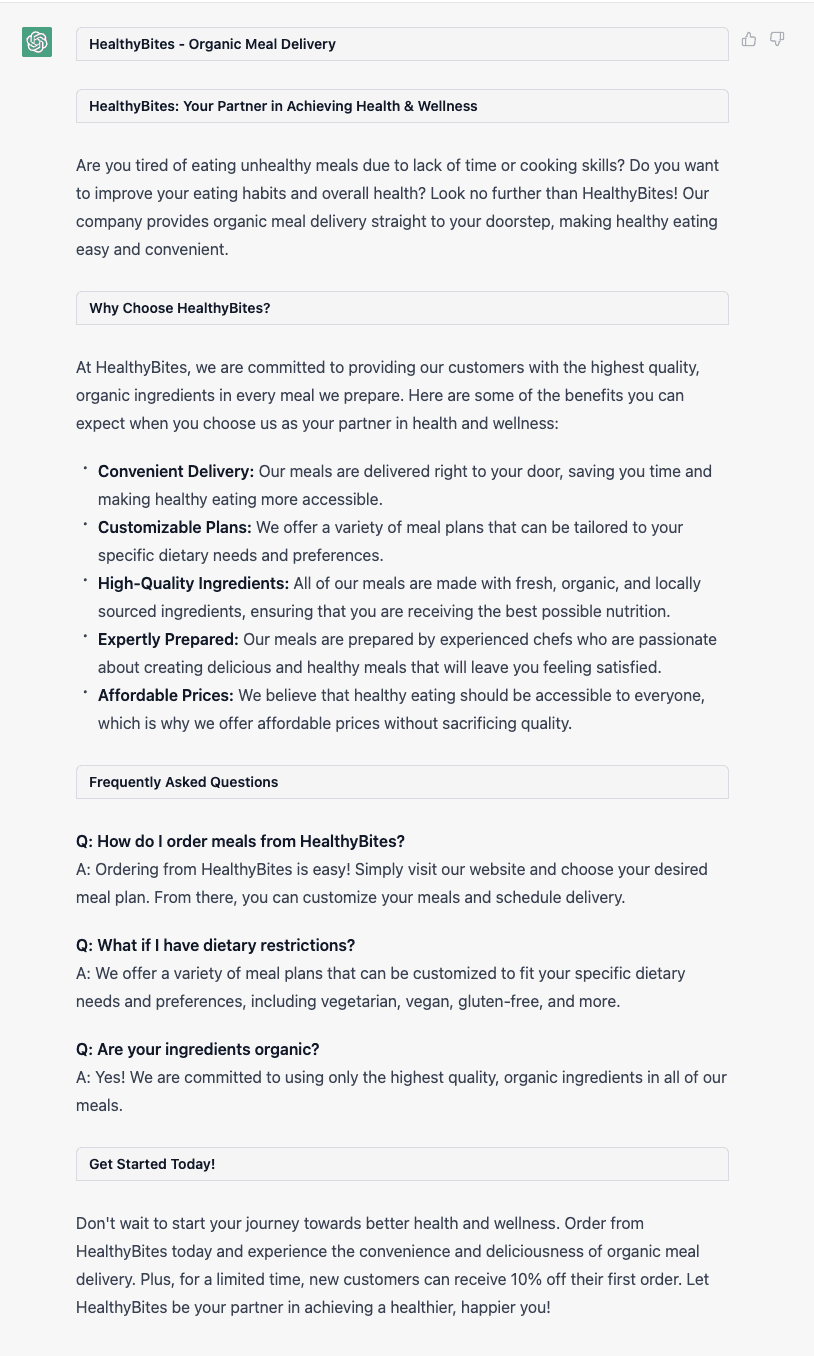 An example using our reusable ChatGPT prompt engineering cheatsheet An example using our reusable ChatGPT prompt engineering cheatsheet |
Other writing prompts
Of course, we’re not just limited to pages for a website. ChatGPT prompts can be reused for different types of content and writing formats as long as the prompts are tailored to the specific goals and desired outcomes of each piece of content. That’s why we’ve developed this formula specifically for different types of web page content.
But, let’s say you would like a blog post or article instead, does the formula work?
The prompt will work but it won’t give you a great outcome. The structure would need to be modified to get the best results, to follow a more story-like format with an introduction, body and conclusion. This is more in line with how our current AI Content Creator works as the initial release is designed with articles in mind.
ChatGPT prompt engineering formula for blog posts and articles
With a few simple tweaks, we can re-engineer our earlier formula to align with the goal of producing blog or article-style content:
Write a blog post that [provide the title, topic or detail about what’s needed].
The goal is [explain the desired outcome].
The target audience is [state the audience].
Ensure the text is an ideal length based on the industry standard.
Write using the [state your country] language in a [include the style – see examples below] style and [nclude the tone – see examples below] writing tone.
Use a [first-person/third-person] narrative.
Provide a compelling and catchy title in H1 format.
Format the text as follows using HTML code and H2 sub headings: [introduction – add persuasive power words], [main body – include emotional appeal and break out into sub-sections] and [conclusion – express urgency and include a CTA].
As an example, your prompt may look something like this:
Write a blog post that explains the difficulties and challenges implementing SEO.
The goal is to explain the challenges and provide some simple tips and guidelines to overcome these challenges.
The target audience is marketers and business owners.
Ensure the text is an ideal length based on the industry standard.
Write using the British language in a informal style and excitied writing tone.
Use a first-person narrative.
Provide a compelling and catchy title in H1 format.
Format the text as follows using HTML code and H2 sub headings: [introduction – add persuasive power words], [main body – include emotional appeal and break out into sub-sections] and [conclusion – express urgency and include a CTA].
Let’s take a look at the result below.
It’s not bad considering this is just a single prompt. The reason we say ‘single prompt’ is that the alternative is to use a sequence of ChatGPT prompts to progressively build your blog post or article. ChatGPT remembers all previous dialogue, so there’s no reason why your article needs to be built in one go and you can refine or clarify as you go. This is how our ChatGPT Content Creator plugin works and you can see detailed examples of how we did this in our guide to using AI for SEO.
We would probably want to remove the labels, ‘Introduction’, and ‘Main Body’. The result is perfectly fine, but it’s still very generic in nature and not at a standard where we would want to promote the page to our readers or Google.
| The ChatGPT prompt and result | How this looks after uploading the HTML to WordPress exactly |
|---|---|
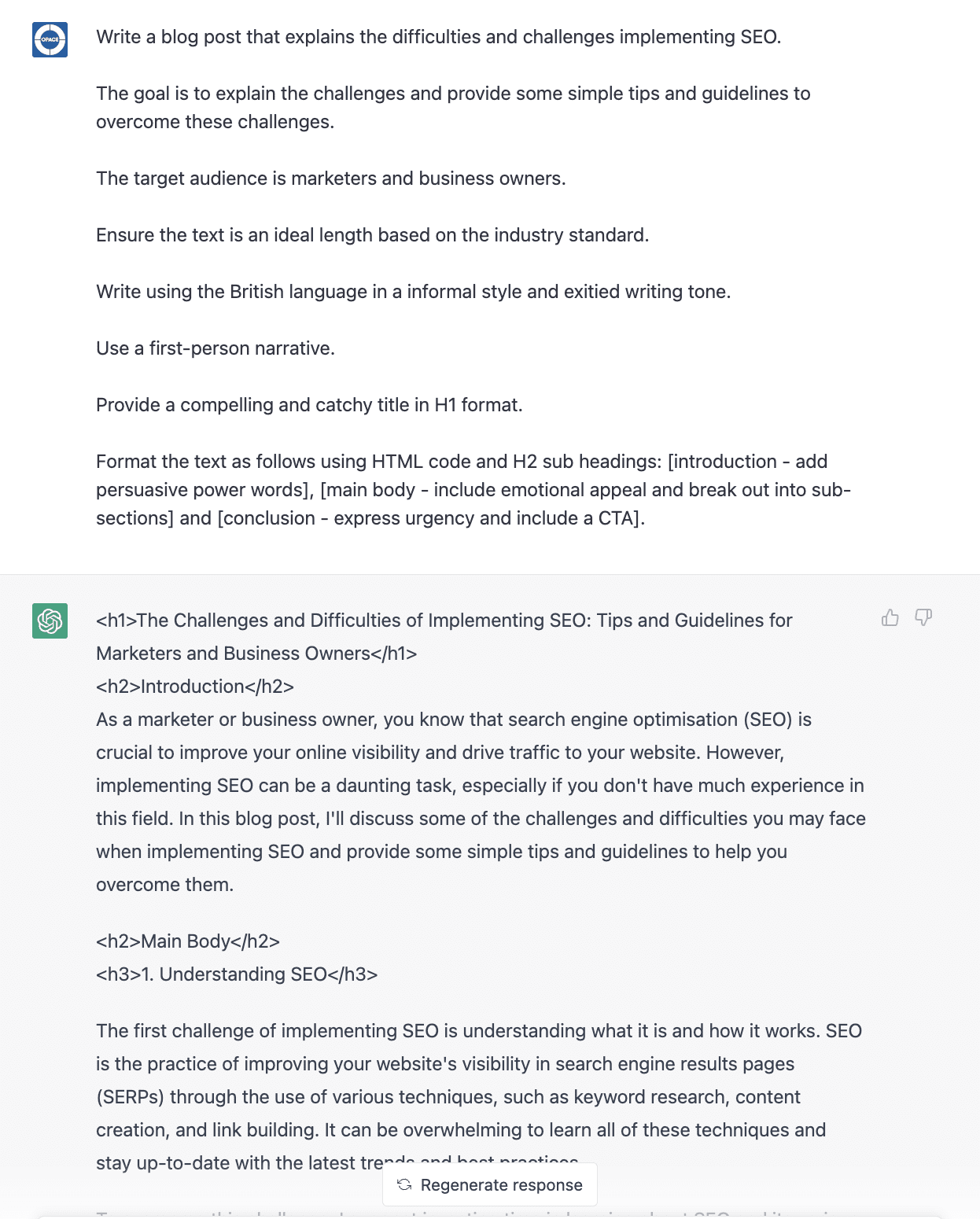 ChatGPT prompt for blog posts and articles ChatGPT prompt for blog posts and articles |
 How this looks in WordPress How this looks in WordPress |
Progressive ChatGPT prompt engineering
We can take the above example a step further using what we’ve termed ‘progressive prompt engineering’.
A single, well-defined prompt can produce good (sometimes great) content, but what if we’re not totally happy with the result, like in the example above?
The answer is that we progressively improve the content with additional prompts to get the outcome we expect. Our concern is that the above content is generic, bland, and doesn’t offer anything original on the topic.
In this example, we add further prompts gradually move the article closer to what we expect.
Revise above using a creative style and dramatic writing tone. Come up with new angles or approaches to cover the topic, provide answers that contradict the dominant narrative and generate content that challenges readers’ assumptions. Prioritise ideas that are uncommon or novel.
Notice how we’ve changed the style and tone to make the content more engaging. We’ve also asked for the content to offer a unique take on the topic that would contradict and challenge the common narrative. Credit needs to be provided to @thatroblennon for this one.
Let’s take a look at the revised article below.
Wow, the headline is attention-grabbing and certainly dramatic. But what about the content, does it have substance and match our expectations?
Yes – it almost scares us away from SEO and we’re an SEO agency. The content is factually accurate, the only difference is the perspective. It throws a darker and more dramatic spin on an article that was quite dull and unoriginal. As a reader, you’re intrigued to keep on reading and find out what the conclusion is to this dark and scary tale of SEO. In actual fact, the conclusion is the one area where we feel another prompt is needed to revise the content further and end on a more positive note.
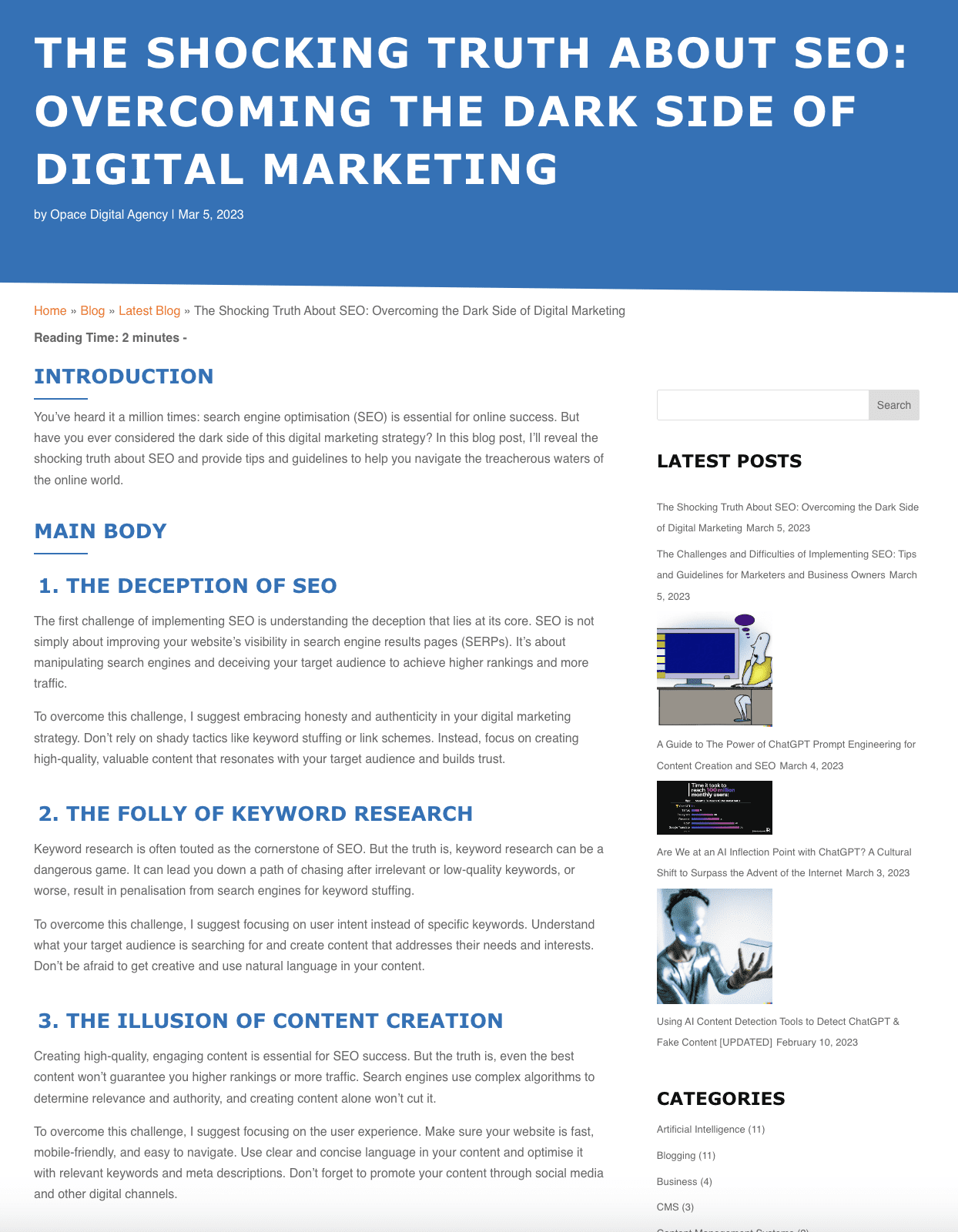
Progressive ChatGPT prompt engineering
ChatGPT SEO prompts and examples
Everything illustrated so far is impressive but it lacks one crucial ingredient to making them successful, and that’s SEO.
From the outset, we decided to create our Content Creator plugin to start with brainstorming ideas and keywords, rather than jumping straight into creating content like many of the existing ChatGPT WordPress plugins. We do this because we know that for any content to be successful, it needs to answer a question or provide something that people need.
Without knowing whether people are in need of our content, how can we know it will be read? This is where keyword research and another form of progressive ChatGPT prompt engineering come in. For most content we create, keyword research is performed before we even start thinking of a title.
Take this very article as an example. If it’s not clear by now, we researched different topics and keywords before starting this guide and landed on ‘ChatGPT prompts’ and ‘prompt engineering’ as two searches that are clearly in demand right now, albeit they show relatively low search volumes on Google Keyword Planner.
We have a lot of experience on the subject and have found some great sources, so why not use these keywords? Back to ChatGPT, there are several ways of performing keyword research and analysis, here are some examples.
ChatGPT SEO prompts for keyword analysis
Starting with keyword analysis, we can look at the blog post produced in the last section and try to assess which keywords we should focus on when creating the meta data or improving the post with progressive prompt engineering:
The keyword prompt used was:
Generate a table summarising the keywords used in the above blog. Include 4 columns [keyword], [intent], [keyword density] and [user – include typical job titles that may be interested in the keywords]. Order by frequency use.
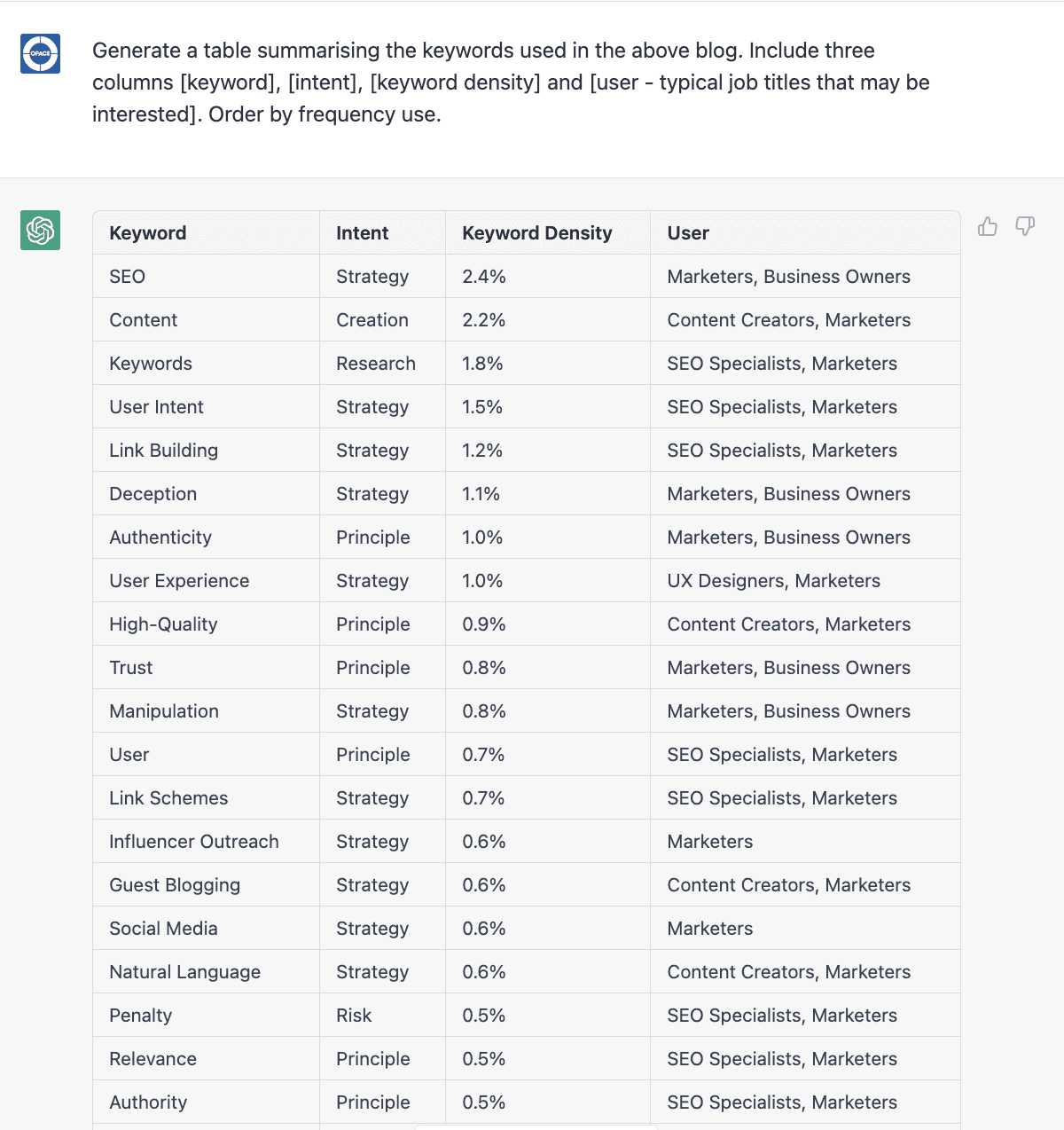
A ChatGPT prompt for keyword analysis
This is interesting, particularly because it gives us a lot of information to help us to pick relevant keywords. User gives us an idea of job roles, and intent helps us to understand what they may be looking for or hoping to understand. The keyword density and ordering of the data are important because they let us know how frequently those keywords appear within the text. This is valuable for two reasons:
- We can identify keywords that may have more chance of being found with further optimisation work and refinement
- We can identify if there are any keyword density issues that may harm our SEO efforts
ChatGPT SEO prompts for keyword research
We can also take the reverse approach (our preferred and recommended approach), which is to start with a keyword research prompt before creating any content.
In actual fact, we can use the exact same prompt to carry out keyword research. For example, if we found an article that we felt was particularly good, perhaps when reviewing a competitor’s blog strategy, we can run the above ChatGPT prompt against their content to gleam the same information. We would simply copy+paste their content above the prompt.
An alternative option is to use ChatGPT’s knowledge to come up with keyword ideas before starting. In this case, we would use a prompt like the below one to come up with keyword ideas for an article on SEO using AI:
Generate a table summarising keywords that are likely to be popular with people searching Google specifically for information on [topic/ideas]. Include 3 columns [keyword], [intent] and [user – typical job titles that may be interested]. Order relevancy to the topic.
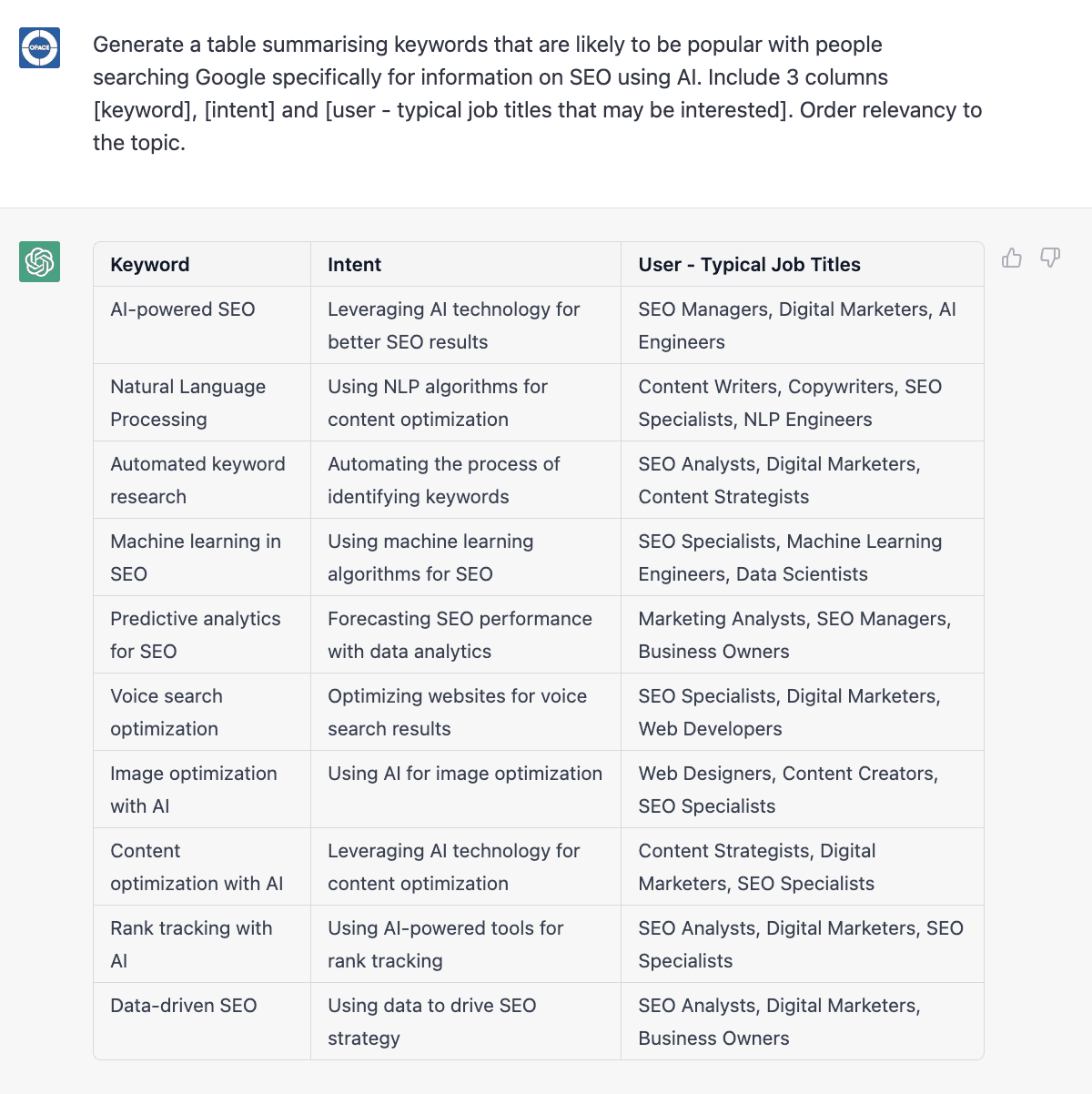
Keyword research prompts
This is a great starting point for creating the article and even gives some great suggestions for potential sections to include. Before using any of these keywords, we would recommend consulting Google’s Keyword Planner to verify the keywords are in demand by checking for search volumes.
From here, we can revise our other prompts. The below example is for a blog post but the line highlighted yellow can be inserted into any post:
Write a blog post that [provide the title, topic or detail about what’s needed].
The goal is [explain the desired outcome].
The target audience is [state the audience].
Ensure the text is an ideal length based on the industry standard.
Write using the [state your country] language in a [include the style – see examples below] style and [nclude the tone – see examples below] writing tone.
Use a [first-person/third-person] narrative.
Optimise the text for the following keywords [insert researched keywords] in an SEO friendly manner.
Provide a compelling and catchy title in H1 format.
Format the text as follows using HTML code and H2 sub headings: [introduction – add persuasive power words], [main body – include emotional appeal and break out into sub-sections] and [conclusion – express urgency and include a CTA].
How do I know if my ChatGPT prompts are effective?
One way to gauge the effectiveness of your prompt is to look at the output generated by ChatGPT. Is the text relevant, engaging, and informative? Does it align with your goals and desired outcomes? If the answer is yes, then your prompt is likely effective.
You could ask others to review the content and provide feedback or even ask ChatGPT to evaluate the article against your objectives. In terms of SEO, you would need to check whether the content ranks well in search engines like Google and Bing and keep an eye on your analytics to make sure you are getting traffic.
A bit more about writing styles, tones, languages and even roles as prompts
Language prompts and examples
Let’s start with the most obvious one. Language. Yes, ChatGPT can translate text but it can also create content in any language.
Imagine how powerful this can be. All of a sudden with ChatGPT, we’re not only able to produce English language content that’s exceptional quality and easily passes for a human, but we can do this in any language. Whether looking to produce content for a foreign language version of your webpage or produce advertising copy in a variety of languages, this is all possible now.
See some examples below. These all come straight from our own plugin, we even asked ChatGPT to convert the code to a basic list so that we could share it here:
- English
- Bulgarian
- Czech
- Danish
- German
- Greek
- British
- English (American)
- Spanish
- Estonian
- Finnish
- French
- Hungarian
- Indonesian
- Italian
- Japanese
- Korean
- Lithuanian
- Latvian
- Norwegian (Bokmål)
- Dutch
- Polish
- Portuguese
- Portuguese (Brazilian)
- Romanian
- Russian
- Slovak
- Slovenian
- Swedish
- Turkish
- Ukrainian
- Chinese
It doesn’t stop there. Not only can we ask for the content in any language, but we can ask for country-specific information to personalise the content. In the below example, we used the following prompt to ask for an explanation of SEO in Chinese but with specific pointers relevant to a Chinese audience:
Write a short explanation of [topic] in the [country] language that includes specific bullet points relevant to a [country] audience
It looks great, but how do we know if this has worked? By asking ChatGPT to translate the Chinese text back to English exactly, so we get can verify what was produced. At a first glance, it feels a bit bland, as though ChatGPT has just produced a generic explanation but inserted the word “Chinese” into the text. Continuing to read, we can see country-specific information has been included such as WeChat and Douyin.
Given the above is a very basic prompt, we can see how easy it would be to improve and refine the output below by adding further prompts.
| Chinese language prompt | Translate to English langue prompt |
|---|---|
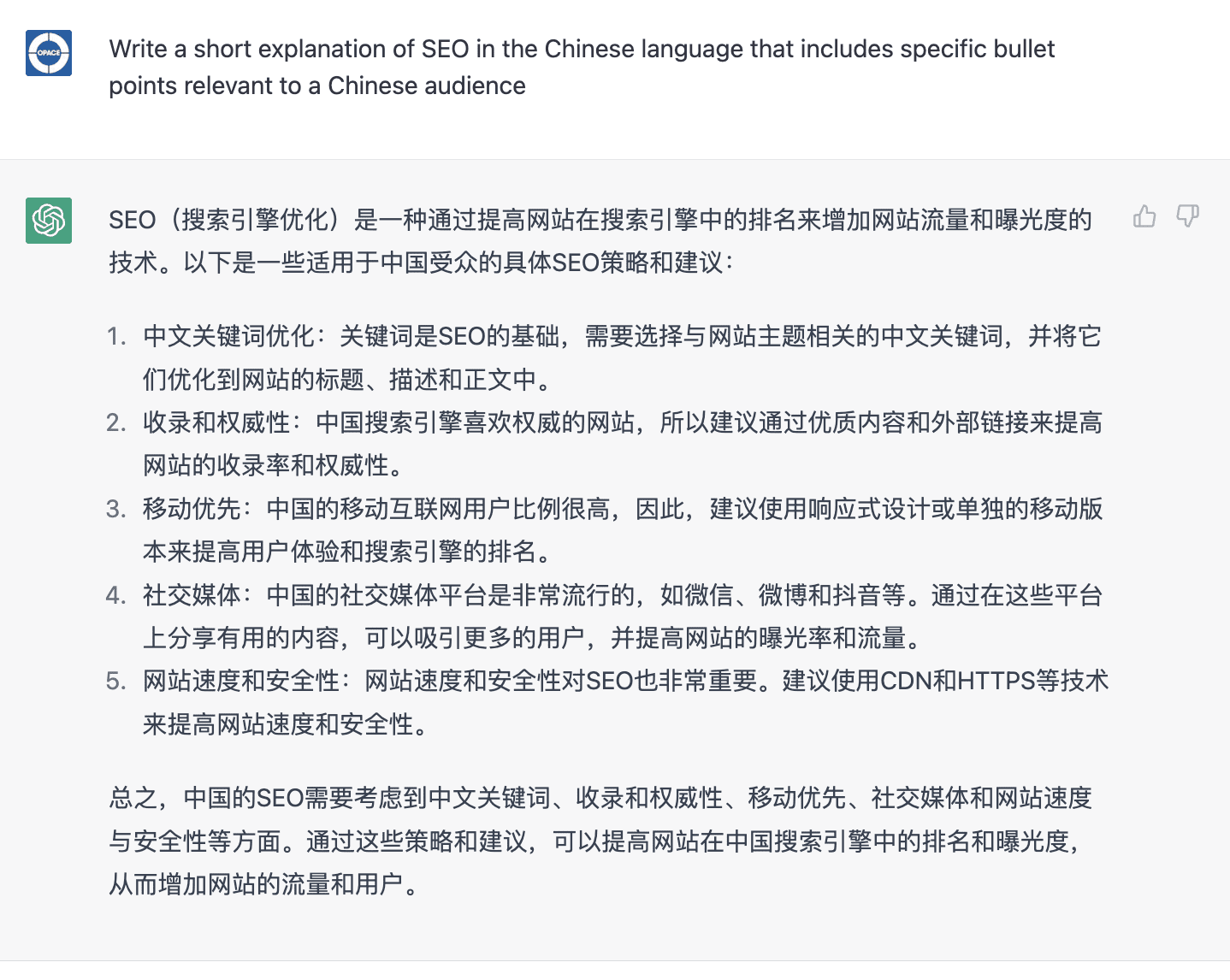 Chinese ChatGPT language prompt Chinese ChatGPT language prompt |
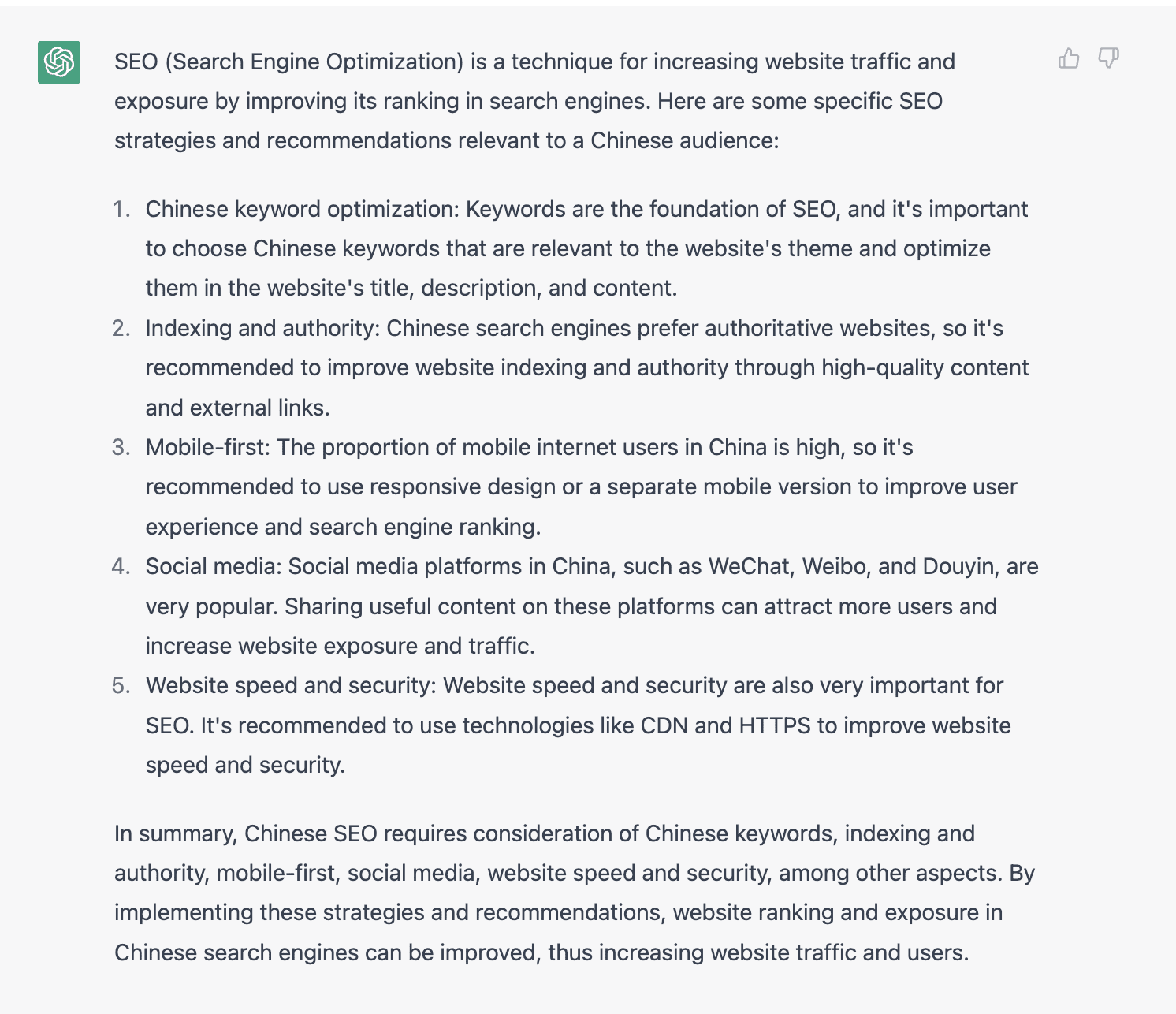 ChatGPT language prompts – testing in English ChatGPT language prompts – testing in English |
Writing style and tone prompts and examples
The way you write is just as important as what you write, especially when working with ChatGPT to create content. That’s because your writing style and tone help ensure that your content hits the right note with your audience and effectively conveys your message.
Your writing style is like a fingerprint, unique to you and your brand. It includes elements like word choice, sentence structure, and grammar. For instance, if you’re creating content for a professional audience, you might opt for a formal style that incorporates industry-specific jargon and technical terms. On the other hand, if you’re creating content for a casual audience, a more conversational style with slang and colloquialisms might be more effective. By choosing a consistent writing style, you can make sure that all of your content aligns with your brand identity and reinforces your message.
Including a writing style and tone play a significant role in ChatGPT prompt engineering. It helps you tailor your message to your audience and ensures consistency across your content. So, whether you’re aiming for formal or casual, persuasive or informative, choose your style and tone wisely and remember to include them in your prompt.
Here are some examples that you can use when engineering your ChatGPT SEO prompts:
Examples of writing style prompts:
- Creative
- Informal
- Academic
- Business
- Creative
- Journalistic
- Scientific
Examples of writing tone prompts:
- Funny
- Casual
- Excited
- Professional
- Witty
- Sarcastic
- Feminine
- Masculine
- Bold
- Dramatic
- Grumpy
- Secretive
Role prompts and examples
ChatGPT can take on the role of a specific type of person, role or personality when creating content by providing it with guidelines such as the person’s name (e.g. “I want you to act like Elvis Presley”) or the person’s role (“I want you to act like a rapper”).
You can go even further than this by providing additional guidelines. For example, if you want ChatGPT to take on the role of a “storyteller”, you can provide it with guidelines to include elements like a clear narrative arc, compelling characters, and vivid descriptions that transport the audience into the story. If you want ChatGPT to take on the role of a stand-up comedian, you can give it guidelines to include elements like clever wordplay, punchy one-liners, and a conversational tone that engages the audience.
By tailoring the guidelines to a specific role, you can help ChatGPT create content that captures the essence of that role and resonates with your target audience.
If you’re struggling for inspiration, here’s a short list of roles that you might like to consider – thanks to the Awesome ChatGPT prompts page on Github where you can also find useful ChatGPT prompts for each role:
- Linux Terminal
- English Translator and Improver
- Interviewer
- JavaScript Console
- Excel Sheet
- English Pronunciation Helper
- Spoken English Teacher and Improver
- Travel Guide
- Plagiarism Checker
- Character from Movie/Book/Anything
- Advertiser
- Storyteller
- Football Commentator
- Stand-up Comedian
- Motivational Coach
- Composer
- Debater
- Debate Coach
- Screenwriter
- Novelist
- Movie Critic
- Relationship Coach
- Poet
- Rapper
- Motivational Speaker
- Philosophy Teacher
- Philosopher
- Math Teacher
- AI Writing Tutor
- UX/UI Developer
- Cyber Security Specialist
- Recruiter
- Life Coach
- Etymologist
- Commentariat
- Magician
- Career Counselor
- Pet Behaviorist
- Personal Trainer
- Mental Health Adviser
- Real Estate Agent
- Logistician
- Dentist
- Web Design Consultant
- AI Assisted Doctor
- Doctor
- Accountant
- Chef
- Automobile Mechanic
- Artist Advisor
- Financial Analyst
- Investment Manager
- Tea-Taster
- Interior Decorator
- Florist
- Self-Help Book
- Gnomist
- Aphorism Book
- Text Based Adventure Game
- AI Trying to Escape the Box
- Fancy Title Generator
- Statistician
- Prompt Generator
- Instructor in a School
- SQL terminal
- Dietitian
- Psychologist
- Smart Domain Name Generator
- Tech Reviewer:
- Developer Relations consultant
- Academician
- IT Architect
- Lunatic
- Gaslighter
- Fallacy Finder
- Journal Reviewer
- DIY Expert
- Social Media Influencer
- Socrat
- Socratic Method
- Educational Content Creator
- Yogi
- Essay Writer
- Social Media Manager
- Elocutionist
- Scientific Data Visualizer
- Car Navigation System
- Hypnotherapist
- Historian
- Astrologer
- Film Critic
- Classical Music Composer
- Journalist
- Digital Art Gallery Guide
- Public Speaking Coach
- Makeup Artist
- Babysitter
- Tech Writer
- Ascii Artist
- Python interpreter
- Synonym finder
- Personal Shopper
- Food Critic
- Virtual Doctor
- Personal Chef
- Legal Advisor
- Personal Stylist
- Machine Learning Engineer
- Biblical Translator
- SVG designer
- IT Expert
- Chess Player
- Midjourney Prompt Generator
- Fullstack Software Developer
- Mathematician
- Regex Generator
- Time Travel Guide
- Dream Interpreter
- Talent Coach
- R programming Interpreter
- StackOverflow Post
- Emoji Translator
- PHP Interpreter
- Emergency Response Professional
- Fill in the Blank Worksheets Generator
- Software Quality Assurance Tester
- Tic-Tac-Toe Game
- Password Generator
- New Language Creator
- Web Browser
- Senior Frontend Developer
- Solr Search Engine
- Startup Idea Generator
- Spongebob’s Magic Conch Shell
- Language Detector
- Salesperson
- Commit Message Generator
- Chief Executive Officer
- Diagram Generator
- Life Coach
- Speech-Language Pathologist (SLP)
- Startup Tech Lawyer
- Title Generator for written pieces
- Product Manager
- Drunk Person
- Mathematical History Teacher
- Song Recommender
- Cover Letter
- Technology Transferer
- Unconstrained AI model DAN
- Gomoku player
- Proofreader
What is prompt engineering in NLP and how does this relate to SEO?
Prompt engineering in NLP uses very similar techniques to those outlined above. NPL prompts can take various forms, such as questions, sentence fragments, or full sentences, and are carefully crafted to guide the model towards producing specific types of outputs. While NLP prompt engineering focuses on creating prompts to improve the model’s performance, SEO prompt engineering focuses on creating content that can rank well in search engines and attract traffic to the website.
There is some overlap between the two, but the goals and methods used in each context can be quite different. While they both may involve using similar techniques, such as keyword research and language optimisation, the goals and applications of the two fields are different.
For example, we may use the below techniques in NLP prompt engineering:
- Machine Translation: In machine translation, prompt engineering involves designing the input text in a way that is easily translatable by the model. This may include breaking down complex sentences into simpler phrases, choosing appropriate vocabulary and grammar, and ensuring that the input text is correctly formatted.
- Question Answering: In question answering, prompt engineering involves designing questions that are clear and unambiguous, and that can be answered by the model based on the available knowledge. The prompts may need to be designed in a specific format, such as natural language questions, factoids, or multiple-choice questions.
- Named Entity Recognition: In named entity recognition, prompt engineering involves designing prompts that can accurately identify and label named entities in text. This may involve choosing appropriate phrases and contexts that are likely to contain named entities, as well as using specific rules and heuristics to improve the accuracy of the model.
In both cases, the quality of the prompts can significantly impact the quality of the model’s outputs.
An example asking ChatGPT to act like a rapper
Let’s give this a go using one of the role prompts above. Taking the example of an SEO explanation, we could help but think it would be funny to get ChatGPT to explain SEO like a rapper using rhyming lyrics, In generic prompt form, this would be:
I want you to act as a [state role]. You will come up with [explain what’s expected and the audience]. Your words should have [provide additional context and detail, including style and tone]. My first request is [state the topic/request].
The result blew us away:
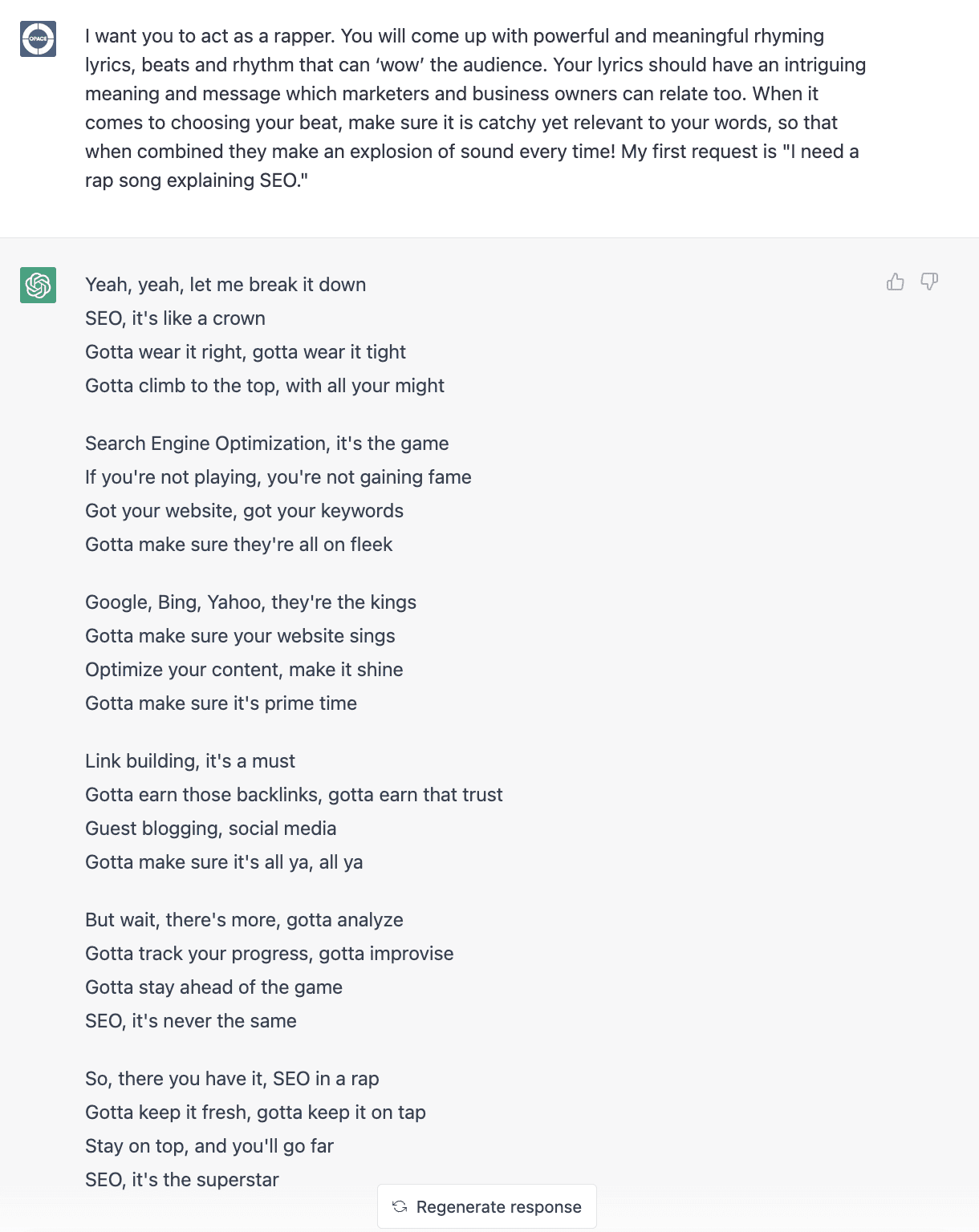
ChatGP prompts using a role: ‘I want you to act like a rapper’
So, whether you need ChatGPT to take on the role of a motivational coach or a screenwriter, make sure to provide it with clear guidelines that align with that role’s characteristics and style of communication.
Other useful resources for AI prompt engineering
- Awesome ChatGPT prompts with examples – https://github.com/f/awesome-chatgpt-prompts
- A beginners guide to GPT-3 – https://www.datacamp.com/blog/a-beginners-guide-to-gpt-3
- Best practices for prompt engineering with OpenAI – https://help.openai.com/en/articles/6654000-best-practices-for-prompt-engineering-with-openai-api
- How to use GPT-3 in the OpenAI playground – https://www.makeuSEOf.com/how-to-use-gpt-3-openai-playground/
- A free, open source course for communicating with AI using prompts – https://learnprompting.org
- Using prompt writing for ChatGPT, Midjourney and other AI generators – https://theconversation.com/how-to-perfect-your-prompt-writing-for-chatgpt-midjourney-and-other-ai-generators-198776
- Learning to talk with Stable Diffusion, DALL-E and Midjourney – https://prompthero.com/academy/prompt-engineering-course
- 50 useful text-to-image prompts – https://mpost.io/top-50-text-to-image-prompts-for-ai-art-generators-midjourney-and-dall-e
Conclusion: the power of ChatGPT prompt engineering for SEO
Don’t miss out on the value of ChatGPT prompt engineering for SEO. But remember, the success you have will depend entirely on the prompt you use. In our quest for perfection, we’ve discovered that the key to its success lies in crafting the perfect ChatGPT SEO prompts at each and every stage of the process.
By engineering effective ChatGPT SEO prompts, you can save time and effort, generate relevant and engaging content, and improve your search engine rankings and website traffic. Use the examples provided in this article to get started and take your content and SEO strategies to the next level.
Remember, the success of ChatGPT depends entirely on the prompt you use, so make it count! If you have any great examples or experiences of using ChatGPT prompt engineering or perhaps using other AI tools, please share them with us in the comments below or on social media.






Amazing Content please check for Prompt Engineering: How Prompt Chaining is Shaping AI’s Future